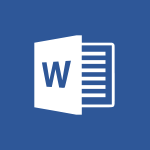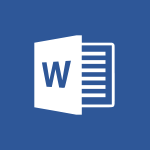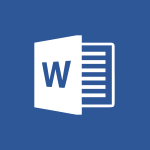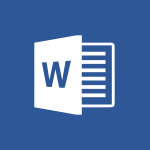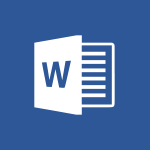Word - Add multiple TOCs to a document Video
In this video, you will learn how to add multiple tables of contents (TOCs) to a document using Microsoft 365. The video covers the process of adding TC fields to each subsection heading, marking the subsection headings with identifiers, and creating the TOCs.
This will help you customize an automatic table of contents to show specific text and improve your document's navigation.
- 4:59
- 2554 views
-
OneDrive - What is OneDrive ?
- 01:14
- Viewed 1574 times
-
Outlook - Create and modify a group
- 2:19
- Viewed 4351 times
-
OneDrive - Edit, Delete a Share
- 02:16
- Viewed 1036 times
-
Power BI - Introduction to Power Bi
- 1:29
- Viewed 6379 times
-
Teams Premium - Activate the features of Teams Premium
- 3:48
- Viewed 13715 times
-
Teams Premium - Optimize Teams Premium settings in Administration
- 1:27
- Viewed 2605 times
-
Viva Engage - The role of an administrator
- 2:22
- Viewed 4818 times
-
Collapsible headings
- 3:03
- Viewed 6685 times
-
Navigation Pane Part 1 : Rearranging a document
- 2:32
- Viewed 3851 times
-
Copy & Paste
- 3:09
- Viewed 3614 times
-
Introduction to Word
- 0:59
- Viewed 3505 times
-
More things you can do with pictures
- 4:53
- Viewed 3205 times
-
Change footnote font, size, and formatting
- 2:48
- Viewed 3188 times
-
Insert icons
- 0:43
- Viewed 3145 times
-
Locate your documents
- 0:20
- Viewed 3126 times
-
Microsoft Search
- 0:34
- Viewed 3094 times
-
Introduction to Tables of Contents
- 2:57
- Viewed 3084 times
-
More options and custom labels
- 3:59
- Viewed 3062 times
-
Insights into what you're working on
- 0:36
- Viewed 2978 times
-
Use dictate to type in Word
- 0:27
- Viewed 2971 times
-
Faster shape formatting and new and modern chart types
- 1:04
- Viewed 2943 times
-
Mail merge
- 3:51
- Viewed 2935 times
-
Take tables of contents (TOCs) to the next level
- 3:51
- Viewed 2932 times
-
3D Models
- 0:42
- Viewed 2928 times
-
Add a logo or other picture
- 3:17
- Viewed 2912 times
-
Format a document
- 2:58
- Viewed 2895 times
-
Translate Content in Word
- 2:04
- Viewed 2895 times
-
Format and add a graphic
- 3:20
- Viewed 2876 times
-
Save, export and share
- 2:08
- Viewed 2831 times
-
Insert items in a document
- 2:59
- Viewed 2825 times
-
Translate your Word documents into any language
- 0:33
- Viewed 2818 times
-
Let Word read your documents out loud
- 0:36
- Viewed 2813 times
-
Ink Equation
- 0:43
- Viewed 2782 times
-
Edit document with natural gestures
- 0:34
- Viewed 2778 times
-
A first look at Word 2016
- 3:16
- Viewed 2738 times
-
Print envelopes with mail merge
- 3:58
- Viewed 2736 times
-
Track changes online
- 3:14
- Viewed 2736 times
-
Design considerations for orientation
- 2:00
- Viewed 2720 times
-
Add headers, footers, margins, and rulers to a page
- 2:45
- Viewed 2703 times
-
Accessibility in Word
- 2:29
- Viewed 2696 times
-
Insert and customize a footnote
- 3:04
- Viewed 2689 times
-
How things are organized
- 2:00
- Viewed 2676 times
-
Check Accessibility in Word
- 1:42
- Viewed 2657 times
-
Navigation Pane Part 2 : Search Options
- 1:35
- Viewed 2628 times
-
Use landscape and portrait orientation
- 3:28
- Viewed 2620 times
-
Custom margin - Headers and footers
- 1:29
- Viewed 2607 times
-
A closer look at the ribbon
- 3:54
- Viewed 2595 times
-
Track changes in email with multiple people
- 4:36
- Viewed 2593 times
-
Modify a TOC with field codes
- 2:59
- Viewed 2590 times
-
Focus on priorities with the Immersive Reader
- 1:13
- Viewed 2590 times
-
Advanced mail merge (Field code)
- 2:59
- Viewed 2585 times
-
Create and print labels
- 3:05
- Viewed 2510 times
-
Chat with co-authors while editing
- 0:29
- Viewed 2502 times
-
Incorporate revisions with track changes
- 3:10
- Viewed 2483 times
-
Pin your important files
- 0:34
- Viewed 2468 times
-
Do things quickly with Tell Me
- 1:04
- Viewed 2425 times
-
Get going fast
- 1:44
- Viewed 2411 times
-
Print letters with mail merge
- 4:02
- Viewed 2405 times
-
Use mail merge to create multiple labels
- 3:21
- Viewed 2393 times
-
Add custom entries to a TOC
- 3:00
- Viewed 2386 times
-
Start working together in a document
- 2:03
- Viewed 2381 times
-
Add formatting to a TOC
- 3:48
- Viewed 2378 times
-
Advanced tables of contents
- 3:15
- Viewed 2346 times
-
Track changes
- 2:34
- Viewed 2346 times
-
Work together in real time
- 1:40
- Viewed 2330 times
-
Customize track changes
- 2:18
- Viewed 2324 times
-
Changing existing styles
- 1:08
- Viewed 2293 times
-
Custom margin - Default margin
- 1:06
- Viewed 2265 times
-
Styles
- 1:49
- Viewed 2261 times
-
Working with watermarks
- 2:48
- Viewed 2145 times
-
Improved version history
- 0:56
- Viewed 2117 times
-
Creating Styles
- 1:03
- Viewed 2111 times
-
Custom margin
- 1:59
- Viewed 2092 times
-
Introducing to Word
- 01:00
- Viewed 165 times
-
Introduction to PowerBI
- 00:60
- Viewed 167 times
-
Introduction to Microsoft Outlook
- 01:09
- Viewed 158 times
-
Introduction to Microsoft Insights
- 02:04
- Viewed 155 times
-
Introduction to Microsoft Viva
- 01:22
- Viewed 161 times
-
Introduction to Planner
- 00:56
- Viewed 169 times
-
Introduction to Microsoft Visio
- 02:07
- Viewed 158 times
-
Introduction to Microsoft Forms
- 00:52
- Viewed 164 times
-
Introducing to Microsoft Designer
- 00:28
- Viewed 224 times
-
Introduction to Sway
- 01:53
- Viewed 142 times
-
Introducing to Word
- 01:00
- Viewed 165 times
-
Introducing to SharePoint Premium
- 00:47
- Viewed 147 times
-
Create a call group
- 01:15
- Viewed 200 times
-
Use call delegation
- 01:07
- Viewed 128 times
-
Assign a delegate for your calls
- 01:08
- Viewed 200 times
-
Ring multiple devices simultaneously
- 01:36
- Viewed 136 times
-
Use the "Do Not Disturb" function for calls
- 01:28
- Viewed 126 times
-
Manage advanced call notifications
- 01:29
- Viewed 141 times
-
Configure audio settings for better sound quality
- 02:08
- Viewed 173 times
-
Block unwanted calls
- 01:24
- Viewed 140 times
-
Disable all call forwarding
- 01:09
- Viewed 141 times
-
Manage a call group in Teams
- 02:01
- Viewed 132 times
-
Update voicemail forwarding settings
- 01:21
- Viewed 130 times
-
Configure call forwarding to internal numbers
- 01:02
- Viewed 123 times
-
Set call forwarding to external numbers
- 01:03
- Viewed 148 times
-
Manage voicemail messages
- 01:55
- Viewed 187 times
-
Access voicemail via mobile and PC
- 02:03
- Viewed 205 times
-
Customize your voicemail greeting
- 02:17
- Viewed 125 times
-
Transfer calls with or without an announcement
- 01:38
- Viewed 121 times
-
Manage simultaneous calls
- 01:52
- Viewed 131 times
-
Support third-party apps during calls
- 01:53
- Viewed 160 times
-
Add participants quickly and securely
- 01:37
- Viewed 132 times
-
Configure call privacy and security settings
- 02:51
- Viewed 130 times
-
Manage calls on hold
- 01:20
- Viewed 137 times
-
Live transcription and generate summaries via AI
- 03:43
- Viewed 126 times
-
Use the interface to make and receive calls
- 01:21
- Viewed 131 times
-
Action Function
- 04:18
- Viewed 139 times
-
Search Function
- 03:42
- Viewed 188 times
-
Date and Time Function
- 02:53
- Viewed 169 times
-
Logical Function
- 03:14
- Viewed 255 times
-
Text Function
- 03:25
- Viewed 200 times
-
Basic Function
- 02:35
- Viewed 158 times
-
Categories of Functions in Power FX
- 01:51
- Viewed 188 times
-
Introduction to Power Fx
- 01:09
- Viewed 159 times
-
The New Calendar
- 03:14
- Viewed 282 times
-
Sections
- 02:34
- Viewed 171 times
-
Customizing Views
- 03:25
- Viewed 166 times
-
Introduction to the New Features of Microsoft Teams
- 00:47
- Viewed 271 times
-
Guide to Using the Microsoft Authenticator App
- 01:47
- Viewed 186 times
-
Turn on Multi-Factor Authentication in the Admin Section
- 02:07
- Viewed 146 times
-
Concept of Multi-Factor Authentication
- 01:51
- Viewed 173 times
-
Retrieve Data from a Web Page and Include it in Excel
- 04:35
- Viewed 392 times
-
Create a Desktop Flow with Power Automate from a Template
- 03:12
- Viewed 334 times
-
Understand the Specifics and Requirements of Desktop Flows
- 02:44
- Viewed 206 times
-
Dropbox: Create a SAS Exchange Between SharePoint and Another Storage Service
- 03:34
- Viewed 349 times
-
Excel: List Files from a Channel in an Excel Workbook with Power Automate
- 04:51
- Viewed 222 times
-
Excel: Link Excel Scripts and Power Automate Flows
- 03:22
- Viewed 228 times
-
SharePoint: Link Microsoft Forms and Lists in a Power Automate Flow
- 04:43
- Viewed 404 times
-
SharePoint: Automate File Movement to an Archive Library
- 05:20
- Viewed 199 times
-
Share Power Automate Flows
- 02:20
- Viewed 193 times
-
Manipulate Dynamic Content with Power FX
- 03:59
- Viewed 197 times
-
Leverage Variables with Power FX in Power Automate
- 03:28
- Viewed 184 times
-
Understand the Concept of Variables and Loops in Power Automate
- 03:55
- Viewed 196 times
-
Add Conditional “Switch” Actions in Power Automate
- 03:58
- Viewed 232 times
-
Add Conditional “IF” Actions in Power Automate
- 03:06
- Viewed 168 times
-
Create an Approval Flow with Power Automate
- 03:10
- Viewed 361 times
-
Create a Scheduled Flow with Power Automate
- 01:29
- Viewed 584 times
-
Create an Instant Flow with Power Automate
- 02:18
- Viewed 338 times
-
Create an Automated Flow with Power Automate
- 03:28
- Viewed 328 times
-
Create a Simple Flow with AI Copilot
- 04:31
- Viewed 306 times
-
Create a Flow Based on a Template with Power Automate
- 03:20
- Viewed 274 times
-
Discover the “Build Space”
- 02:26
- Viewed 192 times
-
The Power Automate Mobile App
- 01:39
- Viewed 200 times
-
Familiarize Yourself with the Different Types of Flows
- 01:37
- Viewed 193 times
-
Understand the Steps to Create a Power Automate Flow
- 01:51
- Viewed 282 times
-
Discover the Power Automate Home Interface
- 02:51
- Viewed 187 times
-
Access Power Automate for the Web
- 01:25
- Viewed 298 times
-
Understand the Benefits of Power Automate
- 01:30
- Viewed 245 times
Objectifs :
This document aims to guide readers on how to create multiple tables of contents in a complex document using field codes in Microsoft Word. It will cover the steps to mark subsection headings, add TC fields, and customize the table of contents for better navigation.
Chapitres :
-
Introduction to Multiple Tables of Contents
In large and complex documents, providing multiple tables of contents can significantly enhance reader navigation. This guide will demonstrate how to utilize field codes in Microsoft Word to achieve this. -
Setting Up Subsection Headings
To begin, we will add TC fields to each subsection heading. Follow these steps: 1. Click in front of the first subsection heading in the first section. 2. Navigate to the Insert tab, click on Quick Parts, and select Field. 3. Scroll down and click on TC. 4. Type the name of the subsection and check 'TC entry in doc with multiple tables'. 5. Check 'Outline level' and type '1' to format the entry with the TOC one style. 6. Click OK. -
Understanding the Field Code
Next, we will reveal the field code: 1. Go to the Home tab and show paragraph marks to see the field code. 2. You will notice the 'f' switch, which allows for multiple tables of contents by assigning a type identifier to the entry. 3. Click after the 'f' and type a space followed by 'x' as the identifier. -
Marking Additional Subsection Headings
To mark the other subsection headings: - Select the field code and copy it. - Delete the text inside the quotation marks and type the new subsection name. - After completing one section, move to the next, changing the text and identifier accordingly (e.g., 'y' for the second section). Repeat this for all subsections, ensuring they are labeled 'x', 'y', or 'z' based on their respective sections. -
Adding the Table of Contents
Once all subsections are labeled, we can add the table of contents: 1. Click the line below the first section heading. 2. Go to the References tab, click on Table of Contents, and select Custom Table of Contents. 3. Click Options, uncheck 'Styles' and 'Outline levels', and check 'Table entry fields'. 4. Click OK twice to add the TOC field code. -
Updating the Table of Contents
If no entries are found in the table of contents, follow these steps: 1. Press Alt and F9 to show the field code. 2. Ensure the 'f' switch has a type identifier. If not, Word defaults to type 'C'. 3. Right-click the code and update the field. 4. Press Alt and F9 again to view the updated table of contents, which should now display only the headings with type 'x' entries. -
Finalizing the Document
To finalize, copy the TOC field code to the other sections, changing the 'f' switch to 'y' and 'z' as needed. Additionally, add a high-level table of contents at the beginning of the document: 1. Click Table of Contents and select Custom Table of Contents. 2. Choose only one level and click OK. This will display only Heading 1 style text. -
Conclusion
By following these steps, you can effectively customize an automatic table of contents in Microsoft Word to display the desired text, enhancing the document's navigability and usability.
FAQ :
How do I create multiple tables of contents in a Word document?
To create multiple tables of contents, use TC field codes to mark each subsection heading with a unique identifier. Then, insert a table of contents for each section, ensuring the correct identifiers are set in the field codes.
What is the purpose of the TC field code?
The TC field code is used to mark specific text in a document for inclusion in a table of contents, allowing for customized navigation within large documents.
How can I update my table of contents in Word?
To update your table of contents, right-click on the TOC field code and select 'Update Field.' You can also press Alt + F9 to toggle the display of field codes.
What does the 'f' switch do in a TC field code?
The 'f' switch in a TC field code enables the use of multiple tables of contents by allowing you to assign a type identifier to the entry.
Can I customize the appearance of my table of contents?
Yes, you can customize the appearance of your table of contents by selecting different styles and levels when inserting it, as well as modifying the TC field codes.
Quelques cas d'usages :
Creating a Comprehensive Report
In a large report with multiple sections, using TC field codes allows the author to create separate tables of contents for each major section, improving navigation for readers.
Organizing a Research Paper
Researchers can utilize multiple tables of contents to categorize different sections of their paper, making it easier for reviewers to find relevant information quickly.
Developing Training Manuals
In training manuals with various topics, adding TC field codes for each section enables the creation of tailored tables of contents, enhancing the user experience for trainees.
Managing Legal Documents
Legal professionals can apply TC field codes to complex legal documents to create multiple tables of contents, ensuring that different sections are easily accessible for quick reference.
Enhancing User Guides
Technical writers can implement multiple tables of contents in user guides, allowing users to navigate directly to specific features or sections, thus improving usability.
Glossaire :
Table of Contents (TOC)
A list of the sections and subsections in a document, typically organized hierarchically, that helps readers navigate the content.
Field Codes
Special codes in word processing software that allow for dynamic content generation, such as tables of contents, by marking specific text.
TC Field
A specific type of field code used in Microsoft Word to mark text for inclusion in a table of contents.
Outline View
A view in word processing software that displays the document structure, showing headings and subheadings in a hierarchical format.
Switch
An option within a field code that modifies its behavior, such as enabling multiple tables of contents.
Identifier
A unique character or string used in field codes to differentiate between different types of entries in a table of contents.
Heading Styles
Predefined formatting options in word processing software that apply specific styles to headings and subheadings, affecting their appearance and inclusion in tables of contents.
